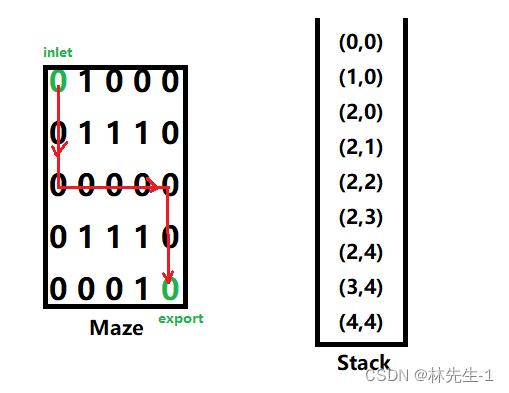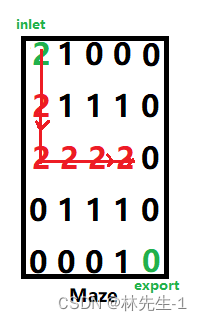【刷题之路Ⅱ】百度面试题——迷宫问题
一、题目描述
原题连接: 迷宫问题
题目描述:
定义一个二维数组 N*M ,如 5 × 5 数组下所示:
int maze[5][5] = {
0, 1, 0, 0, 0,
0, 1, 1, 1, 0,
0, 0, 0, 0, 0,
0, 1, 1, 1, 0,
0, 0, 0, 1, 0,
};
它表示一个迷宫,其中的1表示墙壁,0表示可以走的路,只能横着走或竖着走,不能斜着走,要求编程序找出从左上角到右下角的路线。入口点为[0,0],既第一格是可以走的路。
数据范围:
2≤n,m≤10 , 输入的内容只包含 0≤val≤1
输入描述:
输入两个整数,分别表示二维数组的行数,列数。再输入相应的数组,其中的1表示墙壁,0表示可以走的路。数据保证有唯一解,不考虑有多解的情况,即迷宫只有一条通道。
输出描述:
左上角到右下角的最短路径,格式如样例所示。
示例1
输入
5 5
0 1 0 0 0
0 1 1 1 0
0 0 0 0 0
0 1 1 1 0
0 0 0 1 0
输出
(0,0)
(1,0)
(2,0)
(2,1)
(2,2)
(2,3)
(2,4)
(3,4)
(4,4)
示例2
输入
5 5
0 1 0 0 0
0 1 0 1 0
0 0 0 0 1
0 1 1 1 0
0 0 0 0 0
输出
(0,0)
(1,0)
(2,0)
(3,0)
(4,0)
(4,1)
(4,2)
(4,3)
(4,4)
说明
注意:不能斜着走!!
二、解题
1、方法1——暴力递归
解决这道题我采用的是比较暴力的方法,就是将所有的路都走一遍,因为题目只要求求出一条通路,所以只需要直到一条通路就可以结束了。
1.1、思路分析
那我们要怎样设计递归算法呢?
因为题目是要求我们将路径的坐标依次打印出来,所以很容易想到的就是将走过的路径的坐标依次压入栈中,例如:

只不过最后找到通路后的打印要想将栈中的元素逆置过来再打印。
如果走到某个坐标发现走到了死胡同(上下左右四个方向都走不通),那我们就将当前坐标弹出栈中,返回到上一个坐标继续判断有没有通路。
而为了避免“走回头路”而发生的死递归问题,我们需要将访问过的Maze的坐标的值改成2(其实改成任何数都可以,只要不要改成0就可以):

然后因为我们要压入栈中的是坐标,所以我们可以定义一个结构体pos,来保存Maze中每个元素对应的横坐标与纵坐标:
typedef struct position {
int row;
int col;
} pos;
然后我们就将栈的存储类型改成pos即可。
那我们主要的思路有了,那我们应该怎样设计算法呢?
其实我们主要要实现的只有一个函数——找通路的函数GetPath。
我们在GetPath函数里递归调用上下左右四个方向的找通路,如果当前被调用的坐标等于出口坐标就可以返回,而主要上下左右有任何一个方向的递归调用找到了通路就可以返回(同时最重要的是要先判断坐标的有效性)。
接下来还是看具体的代码实现吧:
1.2、先将栈实现一下
没办法,我用的是C语言,所以还是先要自己造轮子,这其实就只是个CV工程而已:
// 定义一个坐标结构体
typedef struct position {
int row;
int col;
} pos;
// 先要将栈实现一下
// 重定义数据类型
typedef pos DataType;
// 定义栈结构
typedef struct stack {
DataType* data;
int top;
int capacity;
} Stack;
// 栈的初始化
void StackInit(Stack* ps);
// 压栈
void StackPush(Stack* ps, DataType x);
// 弹栈
void StackPop(Stack* ps);
// 返回栈顶数据
DataType StackTop(Stack* ps);
// 返回栈的数据个数
int StackSize(Stack* ps);
// 判断栈是否为空
bool StackEmpty(Stack* ps);
// 栈的销毁
void DestroyStack(Stack* ps);
// 栈的初始化
void StackInit(Stack* ps) {
assert(ps);
ps->data = NULL;
ps->top = 0;
ps->capacity = 0;
}
// 压栈
void StackPush(Stack* ps, DataType x) {
assert(ps);
// 检查是否需要增容
if (ps->top == ps->capacity) {
int newCapacity = ps->capacity == 0 ? 10 : ps->capacity * 2;
DataType* temp = (DataType*)realloc(ps->data, newCapacity * sizeof(DataType));
if (NULL == temp) {
perror("ralloc fail!\n");
exit(-1);
}
ps->data = temp;
ps->capacity = newCapacity;
}
ps->data[ps->top] = x;
ps->top++;
}
// 弹栈
void StackPop(Stack* ps) {
assert(ps);
assert(ps->top > 0);
ps->top--;
}
// 返回栈顶数据
DataType StackTop(Stack* ps) {
assert(ps);
assert(!StackEmpty(ps));
return ps->data[ps->top - 1];
}
// 返回栈的数据个数
int StackSize(Stack* ps) {
assert(ps);
assert(ps->top >= 0);
return ps->top;
}
// 判断栈是否为空
bool StackEmpty(Stack* ps) {
assert(ps);
return ps->top == 0;
}
// 栈的销毁
void DestroyStack(Stack* ps) {
assert(ps);
free(ps->data);
ps->data = NULL;
ps->top = 0;
ps->capacity = 0;
}
1.3、代码实现
因为我们要在多个函数之中使用同一个栈,而每次传参都传一个栈的话就有点太麻烦了。所以我们可以直接将栈定义成全局的。
注意 :因为这里是io型的oj题,所以我们没必要在main函数中最开始就将栈初始化,如果是接口型的oj题,就一定要在main函数中先将栈初始化,不然最多只能过一个测试用例。
// 先定义一个全局栈
Stack pathStack;
main函数:
int main() {
int Row = 0;
int Col = 0;
while (scanf("%d %d", &Row, &Col) != EOF) {
int** path = (int**)malloc(Row * sizeof(int*));
if (NULL == path) {
perror("malloc fail!\n");
exit(-1);
}
int i = 0;
for (i = 0; i < Row; i++) {
path[i] = (int*)malloc(Col * sizeof(int));
if (NULL == path[i]) {
perror("malloc fail!\n");
exit(-1);
}
}
int j = 0;
for (i = 0; i < Row; i++) {
for (j = 0; j < Col; j++) {
scanf("%d", &path[i][j]);
}
}
pos entry = { 0 , 0 }; // 入口
if (GetPath(path, Row, Col, entry)) {
printPath();
}
else {
printf("没有找到通路\n");
}
}
DestroyStack(&pathStack);
}
找通路函数GetPath:
bool GetPath(int** path, int row, int col, pos cur) {
assert(path);
StackPush(&pathStack, cur);
if (cur.row == row - 1 && cur.col == col - 1) {
return true;
}
path[cur.row][cur.col] = 2;
// 判断当前坐标的上下左右四个方向是否能走
pos next = { 0, 0 };
next = cur;
// 上
next.row += 1;
if (isPass(path, row, col, next)) {
if (GetPath(path, row, col, next)) {
return true;
}
}
next = cur;
// 下
next.row -= 1;
if (isPass(path, row, col, next)) {
if (GetPath(path, row, col, next)) {
return true;
}
}
next = cur;
// 左
next.col -= 1;
if (isPass(path, row, col, next)) {
if (GetPath(path, row, col, next)) {
return true;
}
}
next = cur;
// 右
next.col += 1;
if (isPass(path, row, col, next)) {
if (GetPath(path, row, col, next)) {
return true;
}
}
StackPop(&pathStack);
return false;
}
判断坐标是否能走:
bool isPass(int** path, int row, int col, pos cur) {
assert(path);
if ((cur.row >= 0 && cur.row < row)
&& (cur.col >= 0 && cur.col < col)
&& path[cur.row][cur.col] == 0) {
return true;
}
return false;
}
打印通路:
void printPath() {
Stack RPathStack;
StackInit(&RPathStack);
// 将PathStack栈中的数据全都压入RPathStack栈中
while (!StackEmpty(&pathStack)) {
StackPush(&RPathStack, StackTop(&pathStack));
StackPop(&pathStack);
}
pos cur = { 0, 0 };
// 再将RPathStack栈中的数据取出来打印
while (!StackEmpty(&RPathStack)) {
cur = StackTop(&RPathStack);
StackPop(&RPathStack);
printf("(%d,%d)\n", cur.row, cur.col);
}
DestroyStack(&RPathStack);
}```























 449
449











 被折叠的 条评论
为什么被折叠?
被折叠的 条评论
为什么被折叠?










